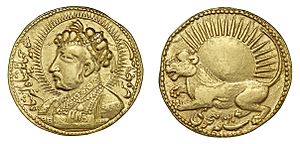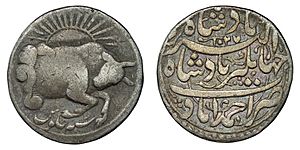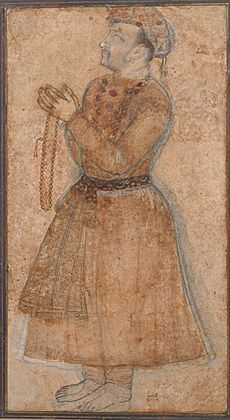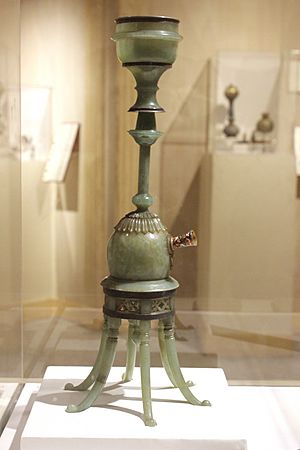Jahangir facts for kids
Quick facts for kids Jahangir Iجهانگیر اول |
|||||||||||||||||
|---|---|---|---|---|---|---|---|---|---|---|---|---|---|---|---|---|---|
| Padishah Al-Sultan al-Azam |
|||||||||||||||||
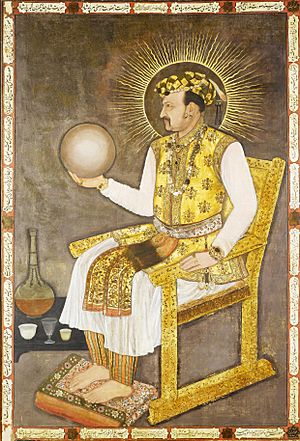
Mughal emperor Jahangir
|
|||||||||||||||||
| 4th Emperor of the Mughal Empire | |||||||||||||||||
| Reign | 3 November 1605 – 28 October 1627 | ||||||||||||||||
| Coronation | 24 November 1605 | ||||||||||||||||
| Predecessor | Akbar | ||||||||||||||||
| Successor | Shahryar Mirza (de facto) Shah Jahan |
||||||||||||||||
| Born | Nur-ud-din Muhammad Salim 30 August 1569 Fatehpur Sikri, Mughal Empire (India) |
||||||||||||||||
| Died | 28 October 1627 (aged 58) Bhimber, Kashmir, Mughal Empire |
||||||||||||||||
| Burial | Tomb of Jahangir, Lahore | ||||||||||||||||
| Consort |
|
||||||||||||||||
| Wives more... |
|
||||||||||||||||
| Issue more... |
|
||||||||||||||||
|
|||||||||||||||||
| House | House of Babur | ||||||||||||||||
| Dynasty | |||||||||||||||||
| Father | Akbar | ||||||||||||||||
| Mother | Mariam-uz-Zamani | ||||||||||||||||
| Religion | Sunni Islam (Hanafi) | ||||||||||||||||
| Royal Seal |  |
||||||||||||||||
Jahangir (born Mirza Nur-ud-Din Muhammad Salim) was the fourth Mughal Emperor. He ruled the Mughal Empire from 1605 until his death in 1627. His name, Jahangir, means "Conqueror of the World."
He was the only son of Emperor Akbar and his chief empress, Mariam-uz-Zamani. Jahangir was born in 1569 and was named after the Indian Sufi saint, Salim Chishti.
Contents
Early Life and Education
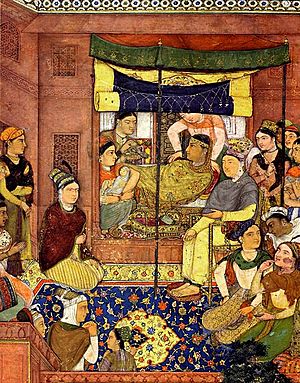
Prince Salim was born in Fatehpur Sikri on August 30, 1569. His parents were Emperor Akbar and Empress Mariam-uz-Zamani. Before Salim, his parents had two other sons who died very young. Because of this, Akbar sought blessings from holy men for a healthy heir.
When his mother was expecting, Akbar ordered a royal palace built near the home of Shaikh Salim Chisti. This was so the Empress could be close to the respected saint. After Salim was born, Akbar was overjoyed. He ordered a big celebration and even released some prisoners.
Salim began his education at age five. His first tutor was Qutb-ud-din. Later, he learned about strategy and military warfare from several teachers. His uncle, Bhagwant Das, also taught him about war tactics. Salim became fluent in Persian and an older form of Hindi. He also knew some Turkic, which was the original language of the Mughal family.
Reign as Emperor
Jahangir became emperor on November 3, 1605, a few days after his father's death. He took the title Nur-ud-din Muhammad Jahangir Badshah Ghazi. He was 36 years old when his 22-year reign began.
Early in his rule, Jahangir faced a challenge from his own son, Prince Khusrau Mirza. Khusrau tried to claim the throne, but Jahangir defeated him in 1606. Jahangir considered his third son, Prince Khurram, to be his favorite.
Later, Prince Khurram (who became Shah Jahan) suspected that his stepmother, Nur Jahan, was trying to make her son-in-law, Shahryar, the next emperor. This led Khurram to start a rebellion against Jahangir in 1622. This caused a political crisis in the Mughal court.
Around the same time, the Safavid ruler Shah Abbas attacked Kandahar in 1622. Kandahar was an important trading city and the burial place of Babur, the first Mughal emperor. Jahangir sent his youngest son, Shahryar, to defend it. However, Kandahar was lost to the Safavids.
In 1623, Jahangir ordered Mahabat Khan, a loyal general, to stop Khurram's rebellion. After many battles, the civil war ended in October 1625.
Foreign Relations

The East India Company asked King James of England to send Sir Thomas Roe as an ambassador to Jahangir's court in Agra. Roe stayed for three years, until 1619. He brought gifts like red wine and explained what beer was.
Roe's visit helped the East India Company get permission to set up a trading post in Surat. While Jahangir didn't give them huge trading rights, this meeting started a relationship between the Mughals and the Company.
In 1623, Jahangir sent his official, Khan Alam, to Safavid Persia. He went to discuss peace after a conflict near Kandahar. Khan Alam returned with valuable gifts.
In 1626, Jahangir thought about forming an alliance. He wanted to join forces with the Ottomans and Uzbeks against the Safavids. He even wrote a letter to the Ottoman Sultan, Murad IV. However, Jahangir died in 1627, so this plan never happened.
Important Marriages
Jahangir had several important wives during his life.
His first main wife was Shah Begum. She was the daughter of his uncle, Raja Bhagwant Das. They married in 1585. Jahangir was very fond of her and made her his chief consort during his time as a prince. He gave her the title Shah Begum after she gave birth to Khusrau Mirza, his eldest son.
Another important wife was Manavati bai, a princess from Rajput. She was the daughter of Raja Udai Singh Rathore. They married in 1586. Jahangir called her Jagat Gosain. She gave birth to Prince Khurram, who later became Emperor Shah Jahan.
In 1596, he married Khas Mahal Begum. She was the daughter of Zain Khan Koka. This marriage was important, and she became one of his main consorts.
In 1608, he married Saliha Banu Begum. She was given the title of Padshah Begum, which means "Empress," and held it for most of Jahangir's reign.
Jahangir married Mehr-un-Nissa, who became known as Nur Jahan, on May 25, 1611. She was the widow of Sher Afgan. Nur Jahan became his most favorite wife. She was known for being smart, clever, and beautiful. After Saliha Bano Begum died in 1620, Nur Jahan became the Padshah Begum. She was very skilled, from designing fashion to helping with building projects.
Major Conquests
In 1594, Jahangir was sent by his father, Akbar, to defeat Vir Singh Deo and capture the city of Orchha. Jahangir arrived with a large army and eventually took control. To celebrate his victory, Jahangir ordered the building of the Jahangir Mahal, a famous Mughal fort in Orchha.
Jahangir also fought against Lakshmi Narayan of Koch Bihar. Lakshmi Narayan accepted Mughal rule.
In 1613, the Portuguese took a Mughal ship called the Rahimi. This ship was carrying valuable cargo and pilgrims going to Mecca. The Rahimi belonged to Mariam-uz-Zamani, Jahangir's mother. When the Portuguese refused to return the ship, Jahangir was very angry. He ordered the seizure of the Portuguese town of Daman and arrested Portuguese people in the Mughal Empire. He also took control of churches belonging to the Jesuits.
Jahangir also brought an end to a long conflict with the state of Mewar. His campaigns against the Rajputs were very strong, leading them to submit to Mughal rule.
In 1608, Jahangir sent Islam Khan I to defeat Musa Khan, a rebel leader in Bengal. Jahangir also captured Kangra Fort in 1615, which had been under Mughal influence during Akbar's time. The fort was taken in 1620. The region of Kishtwar in Kashmir was also conquered in 1620.
Death and Succession
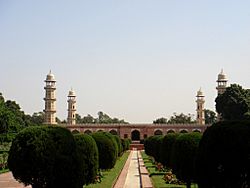
Jahangir was often ill in the 1620s. He tried to improve his health by visiting Kashmir and Kabul. On his way back from Kashmir to Lahore, Jahangir died near Bhimber on October 29, 1627. His body was taken to Lahore and buried in Shahdara Bagh. His son, Shah Jahan, ordered the building of Jahangir's tomb, which is a popular tourist site today.
After Jahangir's death, there was a struggle for who would become the next emperor. Nur Jahan wanted her son-in-law, Shahryar Mirza, to take the throne. However, her brother, Abu'l-Hasan Asaf Khan, supported his own son-in-law, Prince Khurram.
To counter Nur Jahan, Abu'l Hassan placed Dawar Bakhsh as a temporary ruler and kept Nur Jahan confined. When Prince Khurram arrived in Agra in February 1628, he took the throne and became Emperor Shah Jahan.
Royal Family
Jahangir had several sons and daughters:
His sons included:
- Khusrau Mirza (1587 – 1622)
- Parviz Mirza (1589 – 1626)
- Muhammad Khurram (1592 – 1666)
- Jahandar Mirza (born around 1605)
- Shahryar Mirza (1605 – 1628)
His daughters included:
- Sultan-un-Nissa Begum (1586 – 1646)
- Iffat Banu Begum (born 1589)
- Daulat-un-nissa Begum (born 1589)
- Bahar Banu Begum (1590 – 1653)
- Begum Sultan Begum (born 1590)
- Luzzat-un-Nissa Begum (born 1597)
Religion and Beliefs
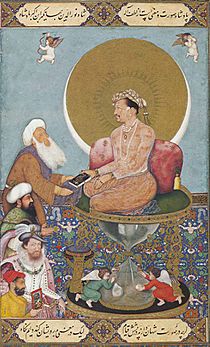
People at the time had different ideas about Jahangir's personal beliefs. Some thought he was not strictly religious, while others saw him as open to many faiths. Sir Thomas Roe, the English ambassador, noted Jahangir's interest in listening to discussions about different religions.
Jahangir was known for his interest in various spiritual traditions. He visited a Hindu ascetic named Jadrup Gosain and was impressed by his knowledge and simple life. He also showed respect for Jain customs, sometimes avoiding meat during their Paryushan festival.
However, Jahangir also took strong actions in some religious matters. He ordered the arrest of Guru Arjan Dev, a Sikh leader, who was later executed. This happened partly because Guru Arjan was suspected of supporting Jahangir's rebellious son, Khusrau. Jahangir also ordered the banishment of Jains from some areas and the destruction of some temples.
Despite these actions, Jahangir generally continued the Mughal tradition of focusing on stability and loyalty rather than forcing religious changes on his subjects. He was open to learning about different beliefs and cultures.
European Influence in Art
Jahangir was fascinated by European art. Jesuit missionaries brought many books, engravings, and paintings to the Mughal court. Both Akbar and Jahangir studied these artworks closely. They copied and adapted European styles, especially the realistic way European artists painted.
Jahangir was proud of his court painters' skills. Sir Thomas Roe wrote about how Jahangir challenged him to tell the difference between an original European painting and several copies made by Mughal artists. Roe couldn't tell them apart, which pleased Jahangir greatly.
Jahangir also encouraged his artists to create unique portraits. Some drawings from his time show faces in full, including the shoulders and head, which was a new style in Mughal art.
Art and Culture
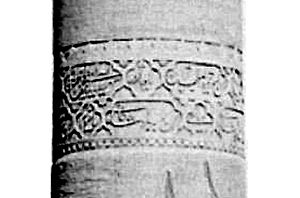
Jahangir loved art and architecture. In his autobiography, the Jahangirnama, he wrote about events during his rule and described plants and animals he saw. He asked court painters like Ustad Mansur to create detailed artworks to go with his writings. For example, he described a beautiful royal falcon and then asked Ustad Mansur to paint it.
Jahangir collected and displayed much of the art he commissioned in special albums. These albums sometimes had hundreds of images, grouped by themes like animals.
Jahangir was very knowledgeable about art. He even claimed he could tell which artist painted any portrait just by looking at it. He also made sure to preserve paintings from his father Emperor Akbar's time. Paintings from his reign were carefully cataloged, dated, and signed. This helps historians understand when and how these artworks were created.
Jahangir's reign was a time of political stability. This allowed him to focus on art and culture. He used his wealth to record the natural world of the Mughal Empire in great detail. Sometimes, he even had artists travel with him to capture images of animals or scenes he found interesting.
Public Health and Medicine
Jahangir was interested in public health. Soon after he became emperor, he issued twelve important orders. Two of these orders were about health and medicine. One order stopped the making and selling of alcohol. Another important order set up free hospitals and hired doctors in all the major cities of his empire.
Historical Views
Some historians have different opinions about Jahangir's rule. Some, like Henry Beveridge, thought he was a weak ruler. They believed he was more interested in things like natural history than governing. They also noted that he lost Kandahar to the Persians. However, they also suggested that his peaceful nature might have prevented more conflicts.
Others criticized him for being too influenced by his wife, Nur Jahan, and for his conflict with his son, Shah Jahan. Sir William Hawkins, who visited Jahangir's court, observed that the empire began to lose some territories that Akbar had gained.
In Media
Jahangir has been featured in many films and television shows.
Films and Television
- In the 1939 Hindi film Pukar, he was played by Chandra Mohan.
- In the 1953 Hindi film Anarkali, he was played by Pradeep Kumar.
- In the 1960 Hindi film Mughal-e-Azam, he was played by Dilip Kumar.
- In the 2013 TV Series Jodha Akbar, he was played by Ravi Bhatia.
- In the 2018 TV series Dastaan-E-Mohabbat Salim Anarkali, he is played by Shaheer Sheikh.
- In the 2023 web series Taj: Divided by Blood, he is played by Aashim Gulati.
Literature
Jahangir is also a character in several historical novels:
- Indu Sundaresan's The Twentieth Wife (2002) and The Feast of Roses (2003).
- Alex Rutherford's Ruler of the World (2011) and The Tainted Throne (2012).
- Tanushree Poddar's Nur Jahan's Daughter (2005).
See also
 In Spanish: Jahangir para niños
In Spanish: Jahangir para niños
- Jahangirnama
- Hiran Minar
- Sheikhupur, Badaun


